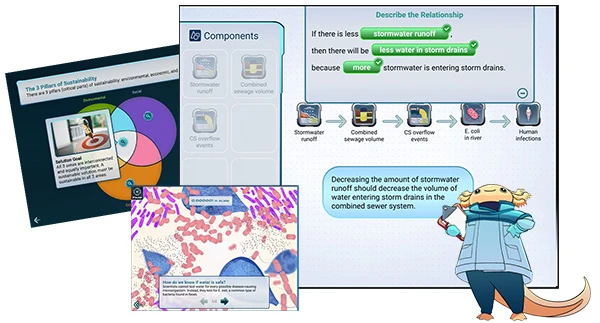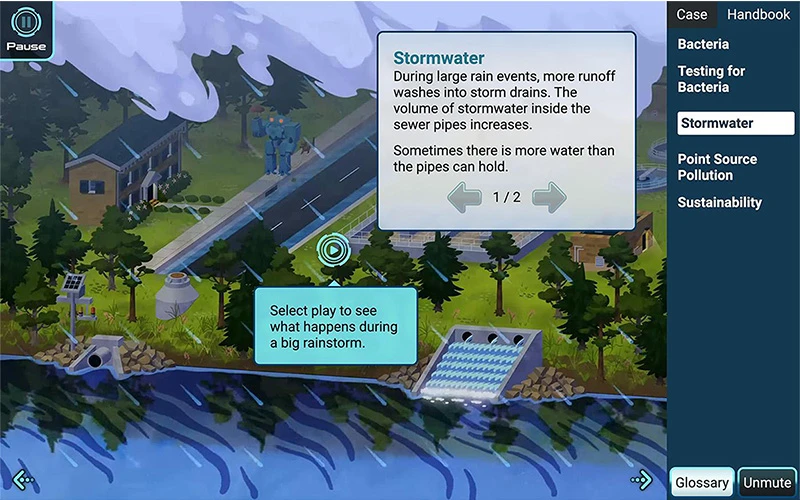New STEM Case Alert: Solve Real-World Challenges in Microbiology

People are getting sick after swimming in the Dogwood River. What’s going on? Your students are tasked with solving the problem. In our newest STEM Case, students become microbiologists to monitor bacteria populations, construct a model of how pollution enters the river, and design a sustainable solution to minimize human impacts on the Dogwood River watershed. Microbiologist Mission: Reducing River Runoff and Pollution is ready for your class.
Dive into the new STEM Case: Microbiologist Mission: Reducing River Runoff and Pollution
People in communities with combined sewer systems closely monitor bacteria levels and have implemented solutions, as students do in this STEM Case, to reduce combined sewage overflows and improve river water quality. ExploreLearning Learning Designer Carrie Adler, Digital Art Manager Hilary Pierce, and the Gizmos STEM Case team collaborated with STEM professionals to bring a real-world scenario to grades 6-8 students.
“Several STEM professionals supported us throughout the design process for this STEM Case. We partnered with the James River Association, which also collaborated with us for the River Detective STEM Case,” said Adler. “For several months, we met with Matt Scott Stone and other JRA scientists and educators every few weeks. They shared water quality data, E. coli testing protocols, and the latest research on freshwater mussel species.”
The Microbiologist Mission STEM Case begins with the student assuming the role of a microbiologist for the Water Resources Department in the fictional city of Millburg. Residents developed bacterial infections after swimming in Dogwood River. The student must find and address the source of the bacterial contamination and ensure that river water is safe for recreation.
“Although the city and river names in this STEM Case are fictitious, combined sewage overflows (CSOs) are a real problem in many communities across the country – we did not make this up! Real scientists and engineers are working on solutions, just as students do as microbiologists in this STEM Case,” said Adler. “I think middle school students will appreciate the gross factor in this STEM Case (Spoiler alert: human and animal feces are washing into a local river during rainstorms!).”
Overview of the Microbiologist Mission
STEM Cases put students in the role of STEM professionals tasked with solving real-world problems. Activating prior knowledge helps students make connections to new information. This particular STEM Case leans into the following ideas:
- All living things are made up of one or more cells.
- Predators consume prey and may reduce or eliminate prey populations.
- Organisms are interdependent with each other and the abiotic parts of their environment; changes to one biotic or abiotic factor in an ecosystem can lead to changes to other factors.
Expectations for both the instructor and the learners are provided through learning objectives. This STEM Case puts students in the lead investigator roles and addresses the following concepts:
- Human actions impact water movement and quality in watersheds.
- Pervious surfaces slow runoff and increase water filtration; impervious surfaces result in less infiltration and more runoff, which carries pollution into streams and rivers.
- Scientists use microbiological testing methods to monitor freshwater resources for evidence of fecal contamination and disease-causing organisms.
- Clear design criteria and constraints (including scientific, economic, and social considerations) support developing and evaluating effective and sustainable solutions.
- Design solutions are tested and modified to improve solutions based on test results.
- Models can be used to describe or predict relationships within a system.
The science behind the sewer river
A watershed is all the land that drains into a particular body of water. The type of land cover affects the movement of water over and through the land. Pervious surfaces, like forests and other vegetation, slow water flow and allow more water to infiltrate the ground. Impervious surfaces, such as hard surfaces like roads and building roofs, do not absorb much water. Impervious surfaces result in more runoff, which carries pollution into waterways.
With that in mind, engineers develop and evaluate solutions to problems. Design solutions must be sustainable, meaning that they meet the needs of people today without harming future generations. Sustainable solutions do not harm ecosystems, people’s well-being, or a community’s financial stability or growth.
In this STEM Case, students discover bacteria associated with fecal contamination in a river. Bacteria are a diverse group of unicellular, prokaryotic organisms that live in a wide range of habitats, including the bodies of other organisms. Escherichia coli (E. coli) is a rod-shaped, gram-negative bacteria commonly found in the intestines of warm-blooded animals, including humans. Because E. coli spreads through feces, its presence in water indicates fecal contamination. Laws regulate the amount of E. coli permitted in drinking water and freshwater bodies used for recreation.

Exploring microbiology in real-world contexts
Adler knows the way middle schoolers think. As they investigate the movement of stormwater to determine how feces gets into the river after heavy rains and observe how sewage and E. coli enter the Dogwood River, they’ll make it relevant to their lives. “I hope students wonder: Wait, do I live near a combined sewage overflow pipe?!? Is my poop going into my local river?!? How can I increase pervious surfaces in my community to reduce runoff and water pollution?”
How environmental science meets problem-solving
Environmental science addresses problems using scientific principles to understand environmental issues, identify their causes, and develop solutions. Environmental problem-solving also requires collaboration and effective communication. In this STEM Case, students put those skills to work as they form and test ideas to find solutions.
Key features of this interactive STEM simulation
The new STEM Case (and every other one!) frames learning with real-world experiences that your students will want to explore! Students learn the science required to solve the problem and collect data to inform their investigations. Throughout the exploration, teachers can count on:
- Engaging simulations and microbiologist activities
- Aligning content with science standards
- Building critical thinking and inquiry skills
- Enhancing STEM learning through hands-on exploration
- Encouraging independent thinking as well as collaboration
Get started with the microbiologist mission today!
The new STEM Case has everything teachers need to dive into the mission – from vocabulary to assessments. Students begin by constructing a model to describe the cause-and-effect relationship between E. coli and human infections. Throughout the STEM Case, students can select different solutions to test and hypothesize how this solution will sustainably reduce bacteria levels in the river. Through their work, students discover and communicate the best solution! No spoilers here. Let the exploration lead to the discovery!
How to access the new STEM Case
The new STEM Case is ready for your students! Get ready to investigate and address the source of the bacterial contamination and make sure that river water is safe for fun and recreation.
Additional resources for educators
Adler shared a fun fact for teachers and students. “Our newest STEM Case character, Mecha Axl (a robotic axolotl assistant) makes a brief cameo in this STEM Case,” she said. “Can you spot him?”

After completing this STEM Case, students may wonder about water quality in their local rivers and streams and what kind of sewer system they have. Inspire students to get involved in water-quality citizen science projects in their local watersheds. The teacher guide includes resources to keep the investigation going:
- How healthy is my waterway? Students can search by address or zipcode to find water quality data and evaluations.
- Is there a Combined Sewage Overflow Outfall near me? Explore the interactive U.S. map to find CSOs in approximately 700 communities.
Haven’t tried Gizmos in your classroom yet? It’s time! Start your free trial today.